Your Guide to Venomous Snakes in Adelaide

Bites and Stings
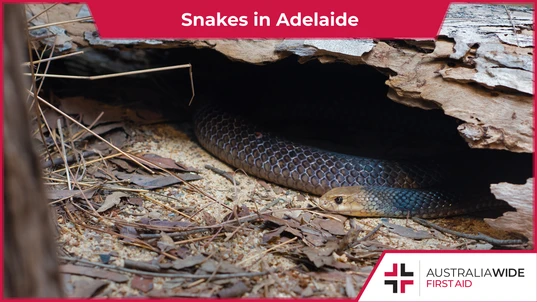
Adelaide comprises a wide range of bushland, rural, and semi-rural environments. As such, it is home to a variety of native wildlife, including venomous snakes. Some of the most commonly encountered snakes in Adelaide are highly dangerous to humans.
Owing to its abundance of national and conservation parks, Adelaide is home to a wide variety of native wildlife, including venomous snakes. In this article, we look at the characteristics and preferred habitats of 5 of the most commonly encountered venomous snakes in Adelaide. For the most part, these snakes have highly toxic venom that can affect living cells and cause dangerous symptoms ranging from bleeding and nausea to irregular heart beat and death. It is important to remember, however, that these snakes will never go out of their way to attack you. In fact, most bites occur when people attempt to approach, capture, or kill snakes. If you need a snake relocated from your home, contact a snake catcher, instead. And to learn about identifying and treating snake bites, head to one of our general or childcare first aid courses near you in Adelaide.
The Red bellied black snake is a shy species that generally only bites under severe harassment. Their venom can disrupt the body's ability to clot blood, as well as damage muscle cells.
The Red bellied black snake
Appearance
- Moderate to robustly built body ranging from 1.5 to 2 m in length
- The scales on their back and sides are smooth, glossy, and uniformly black
- The lowermost rows of scales on their sides are bright crimson and fade to pink as they reach the middle of the underbelly
Habitat
A distinct population of Red bellied black snakes occurs at the southern end of the Mount Lofty Ranges, including:- Near streams, swamps, and other moist habitats within forests, woodlands, and grasslands
- Near drainage canals and farm dams in disturbed areas and rural properties
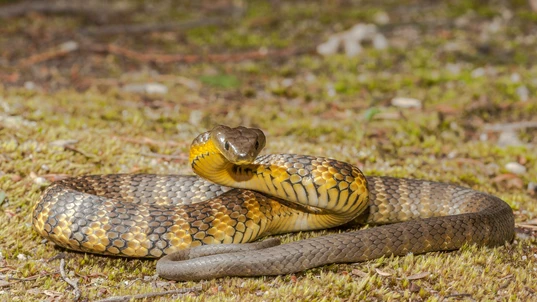
The Tiger snake generally prefers to escape in the face of conflict, though they will adopt a threat display if cornered. Their venom can disrupt nerve cells and the body's ability to clot blood.
The Tiger snake (Notechis scutatus)
Appearance
- Thick, muscular body ranging from 1 to 1.5 m long
- Body scales ranging from dark olive brown to black, interspersed with vertical off-white to yellowish bands (though some individuals may be pattern-less)
Habitat
Tiger snakes are mainly found in and around the Murraylands and the Fleurieu Peninsula, including Kangaroo Island. This includes:- Watery environments, such as creeks, rivers, or swamps
- Highly degraded areas, such as pastoral lands

The Eastern brown snake is an alert and nervous species, and they will often react defensively if surprised or cornered. Their venom is highly potent and can disrupt cells in the nervous, cardiovascular, and renal systems.
The Eastern brown snake
Appearance
- Slender to moderately built body ranging from 1.5 to 2 m long
- The scales on their back and sides are smooth, slightly glossy, and can be almost any shade of brown, from near black to light tan
- The scales on their underbelly are generally cream and interspersed with brown, grey, or pinkish-orange blotches
Habitat
The Eastern brown snake is the most common snake in South Australia and is regularly encountered in Adelaidean suburbs. They can be found in a wide range of habitats, except for rainforest and alpine regions, and generally shelter in or under:- Animal burrows
- Fallen logs
- Man-made debris
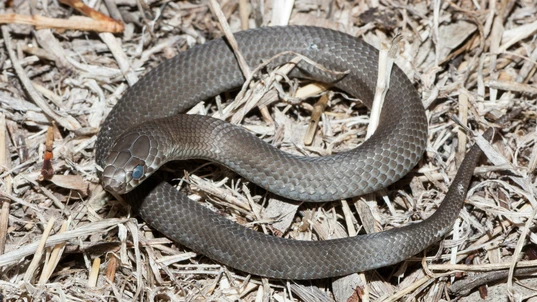
Copperhead snake species generally only lash out and bite when cornered and provoked. Their venom can destroy nerve cells, red blood cells, and other living cells.
The Pygmy copperhead
Appearance
- Muscular, moderately robust body that can reach 115 cm in length
- The scales on their back and sides are semi-glossy and uniformly grey brown to blackish
- The lowermost rows of scales on their sides are enlarged and usually paler, while their underbelly can range from cream to grey
Habitat
The Pygmy copperhead can be found in the high altitude forests of the Mount Lofty Ranges, and in a wide variety of habitats on Kangaroo Island, including:- Coastal dunes
- Open grassland
- Closed woodland
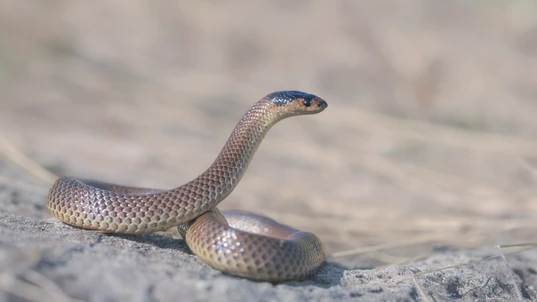
When disturbed, the Little whip snake has been known to hurl itself about and emit a foul smell. Their small size and venom dosage means that they are virtually harmless to humans.
The Little whip snake
Though Little whip snakes are venomous and can cause pain, they are virtually harmless to humans.Appearance
- Small, slender body that generally only reaches 45 cm long
- A black, hourglass-shaped patch that extends from the back of the nape to between the eyes
- The scales on their back and sides can range from tan to orange and have a dark edge
Habitat
The Little whip snake can be found west to south east of South Australia, including:- Grasslands
- Grassy woodlands
- Well drained hillsides
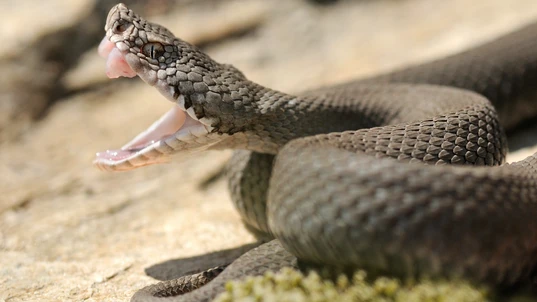
The best way to avoid snake bites is to leave snakes alone. Make sure to wear boots and trousers when bushwalking, and do not put your hands or feet in or under logs, rocks, or other debris without first checking if a snake is present.
Final thoughts
Head to our Resource Library for information about identifying and treating bites from some of Australia's deadliest snakes. We also cover snake bites in our general and childcare first aid courses. We have training locations in every state, capital city, and major town throughout Australia, including Adelaide - head to our website to find and enrol in a first aid course near you today.
Originally published at
https://www.australiawidefirstaid.com.au/resources/snakes-in-adelaide
as part of the Australia Wide First Aid Articles Library









